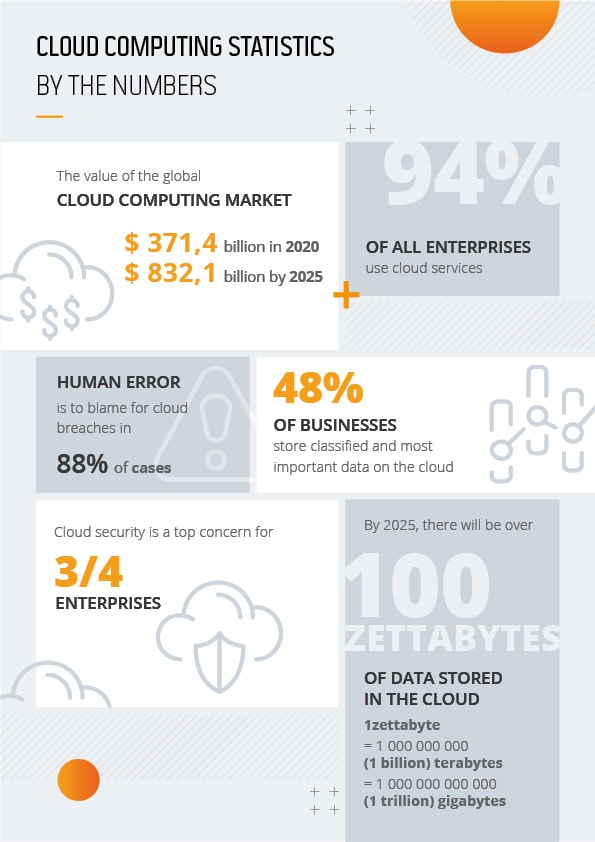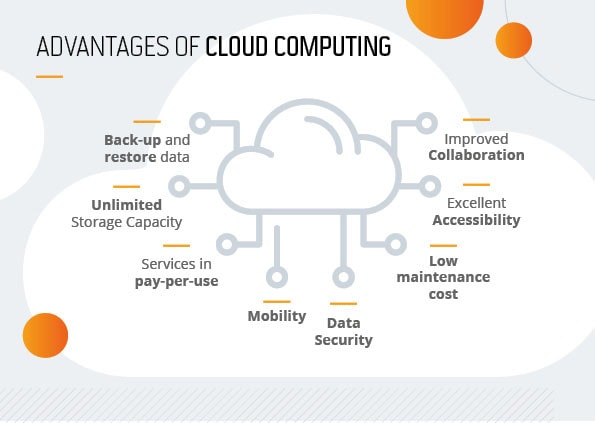
How Cloud enables Digital Transformation and accelerates it?
Digital transformation is more than integrating digital technology in all areas of your business and changing the way you operate, as well as, deliver value to your customers. It also implies a cultural change that requires organizations to challenge themselves constantly.
How does the Cloud enable Digital Transformation?
Digital Transformation is fueled by the rapid growth of cloud solutions, resulting in an increasing number of companies adopting a cloud-first policy. According to Gartner, by 2024, more than 45% of IT spending on system infrastructure, infrastructure software, application software, and business process outsourcing will shift from traditional solutions to the cloud.
What is even more impressive, another study conducted by Gartner shows that by 2025, 55% of large organisations will implement a cloud-only strategy.
Why is the cloud so appealing to business? Here are some main benefits:
Increasing security
Many people are afraid of losing control over their data and infrastructure. However, it turns out that by migrating to the cloud, we can significantly reduce the risk of data loss and unauthorised access. Public cloud service providers implement the best cloud security measures to protect data, applications, and the entire infrastructure from potential threats. Besides, in cloud, backups are created automatically, which reduces the risk of losing them.Lower costs
Cloud computing reduces the costs of purchasing hardware and software and operating data centres. For example, by storing your data in the Snowflake Cloud Data Warehouse, You do not have to worry about server maintenance (related to space, energy, cooling, electricity consumption, and payments for IT employees). The costs of using the cloud itself are also reduced. In general, You only pay for the resources you use.Higher efficiency and reliability
With minimal costs of using cloud computing, you can have maximum efficiency. Secured cloud computing data centres offer the latest generation of equipment, ensuring reliable performance. Few small and medium-sized enterprises could afford such solutions on their own. Fortunately, they can use them without restrictions as part of cloud computing. If you do not know which cloud service provider is best for your company, please fill out the form at the end of this article, and our specialists will contact you back.Flexible scalability
You use and pay for as much as you currently use. Cloud computing flexibly adapts to your organisation’s needs, providing as much computing power, resources and bandwidth as you need at a specific time. And you only pay for this particular capacity. You reduce or increase resources when you want. What’s more – you have a constant overview of their usage status.
How to accelerate Digital Transformation through Cloud technology?
To align digital changes with their business goals, companies should embrace innovative ideas that are both smart and achievable. This can be done by utilising every available tool and technology to create a robust digital setup.
As the tech world is ever-evolving, continuous learning and adapting are of utmost importance. Companies must explore new trends and evaluate their compatibility to stay ahead of the curve.
Cloud computing will unlock a new level of productivity
According to Richard Kneller, Professor of Economics at the University of Nottingham:
There’s some evidence that cloud enables firms to do things which make them more productive. That would help to improve that gap relative to the average, but one of the key elements in the way that the cloud improves productivity is by enabling new firms to enter markets where firms are typically more productive and then grow and scale very quickly. That then helps to raise that average overall productivity measure.Richard KnellerProfessor of Economics at the University of Nottingham
We can go even one step further and say that cloud computing is almost all about productivity. For example, it facilitates employee collaboration in real-time, regardless of the location from which each team member is physically working. Several platforms make communication, cooperation, and document sharing a breeze (such as Zoom or Microsoft Teams).
Also, it supports the BYOD (bring your own device) policy, which is gaining popularity worldwide. The ability to access cloud services from any device (and also simply being allowed to do this) makes employees more productive and responsive.

Cloud computing also reduces downtime since cloud providers do everything they can to respond to any issues immediately. Plus, it supports flawless data management and allows companies to quickly modify their business models and scale up or down, smoothly adapting to changing market conditions. All of these things boost productivity like nothing else.
It’s not just about efficiency; it’s about accessibility
Ease of access to applications via an Internet connection can be a decisive factor in terms of business continuity.
In case any disruptions occur in the external environment or internal infrastructure, companies can swiftly go remote, allowing employees to work from the location of their choice.
This way, they don’t have to put their business activities and ongoing tasks on hold, which can be extremely costly, even for a short period.
The improved connection speed to company systems and data and better access to relevant information allow organisations to effectively work from anywhere, anytime. Moreover, customers might not notice that something has changed in the company’s modus operandi since they will still get what they pay for without interruption and receive support whenever needed.
And this dynamic also applies to businesses and their cloud service providers. The latter does what it takes to ensure service continuity and offer IT support on the highest level, often around the clock, which, these days, is absolutely invaluable.

Cloud computing unlocks innovation and creativity in marketing
Cloud computing is also leveraged by sales and marketing teams since they can make use of the quick and easy access to relevant customer data and valuable insights that it offers.
Information they can get via a wide variety of cloud-based analytics tools helps them understand their target audiences better than ever.
Advanced CRMs, social media management solutions, and analytical SEO and customer data platforms allow decentralised specialists to build precise and successful sales and marketing campaigns. Along with cloud-based SEO tools, they can optimise everything else, from targeting to content creation to lead generation and more.
And all of this happens in real-time, enabling lightning-fast reactions so teams can respond to customer problems quickly. Plus, this also gives them better control over marketing campaigns so that they can steer them in the right direction, adjusting methods, messages, and timing.
Security considerations in Cloud-Based Digital Transformation
When companies decide to upgrade their systems using cloud technologies, ensuring security becomes a top priority. The cloud is more susceptible to attacks, which puts data safety at risk. Although the cloud can help save costs and improve efficiency, it also comes with challenges like data leaks and heavy reliance on third-party providers.
It is crucial to remember that while the cloud provider is responsible for their systems, companies must protect their data. Therefore, having a robust cloud security management is vital.
Combining the Cloud with other technologies for comprehensive transformation
Combining cloud computing with new technologies like AI & ML, IoT, and blockchain can lead to significant improvements in business operations. Using the cloud’s easy storage and processing features, alongside these advanced tools, allows for better decision-making, cost savings, and new business opportunities.
Future trends: how Cloud will continue to shape Digital Transformation
In the future, cloud computing will play an increasingly more crucial part in advancing cloud-enabled digital transformation. The adoption of cloud-native solutions shows that businesses are preparing for the future of digital services.
Organisations willuse a hybrid and multi-cloud approach to use different cloud providers and systems.
Modernising IT architectures with cloud, headless, and API-first design will enablecompanies to expand their digital activities.
Using cloud resources for data-driven decision-making will important for entities that want to stay competitive in the market.
Of course, these challenges can all be turned into opportunities and used to build competitive advantage — but only when the cloud adoption is done in a smart way.
You can choose to hire experienced cloud experts or cooperate with a solid IT partner (we at Future Processing can be of assistance here!). Both ways can produce equally good results, and it’s much better than just throwing yourself into the deep end single-handedly.
Examples of Cloud and Digital Transformation initiatives
There are many examples of cloud and digital transformation initiatives that have helped businesses optimise their operations, improve customer experiences, and discover new growth opportunities using modern technologies.
We can mention companies such as:
Ikea – Ikea implements an innovative e-commerce application that uses augmented reality. It help customers to arrange the interior and choose, among others, colours and details of the decor by providing personalised recommendations.
Porsche – Porsche is offering several new digital services to its customers, thanks to the One Digital Platform (ODP), based on IoT and Digital Twin technologies. These services make the use of Porsche cars even more versatile, integrating them into the digital environment in which their users live.
By understanding the challenges they encountered, the strategies they implemented, and the results of their efforts, we can learn from their experiences.
For more examples, visit our blog post listing 10 organisations with successful digital transformation.
Choosing the right Cloud model for your Digital Transformation journey
There are three types of cloud models: public, private, and hybrid clouds, each with unique benefits and suitable for different business needs.
Public Cloud is a cloud service offered by third-party providers, which is available to anyone who wants to use or purchase it. The model offers advantages such as scalability, accommodating multiple users, and a flexible pay-as-you-go pricing structure.
Private Cloud, on the other hand, is a cloud environment that is exclusively used by a single business or organisation. It offers enhanced security and control tailored specifically to the organisation’s unique needs.
Hybrid Cloud is a combination of both public and private clouds. It allows data and applications to be shared between them, offering a balance of scalability from the public cloud with the control and security of a private cloud.
If you want to find out more about them, you should read our article: Public Cloud vs Private Cloud vs Hybrid Cloud: What are the differences?
How to keep up with the evolving landscape of Cloud and Digital Transformation
Keeping up with the dynamic world of digital transformation requires a combination of strategy, awareness, and collaboration.
Here’s a simplified approach:
Evaluate your current technological environment: Understand the tools you’re using, identify potential shortcomings, and ensure your tech aligns with your business aims.
Stay informed and updated: The tech world is in a constant state of flux. To stay relevant, make it a habit to attend tech conferences, read relevant journals, and follow industry experts online.
Team up with the right people: Remember that digital transformation is a collective journey. Collaborate internally with IT teams and business heads, and also consider external input from tech vendors or consultants for a fresh perspective.
Set clear priorities: In a vast sea of potential upgrades and changes, decide what’s crucial. Pinpoint immediate, impactful changes and also plan for meaningful long-term transformations.
Commit to continuous learning: The rapid pace of technological advancements requires continuous learning. Engage in online courses, training workshops, or attend tech events like hackathons to stay up-to-date with the latest knowledge.
When in doubt, contact Future Processing to discuss the synergy of digital transformation and cloud technology. We have over 20 years of experience providing high-quality digital transformation services.





